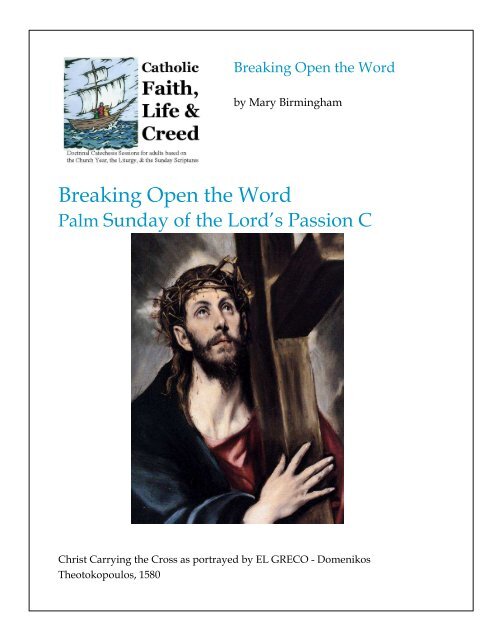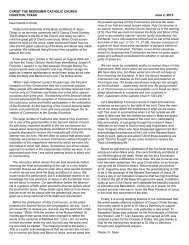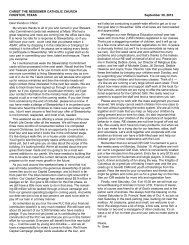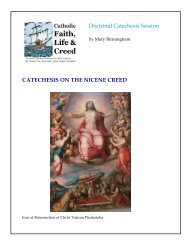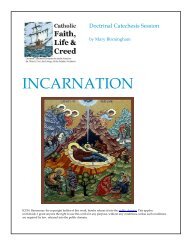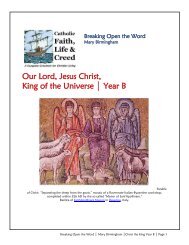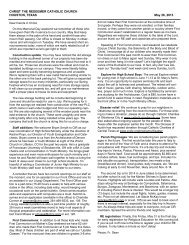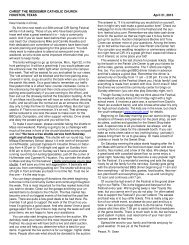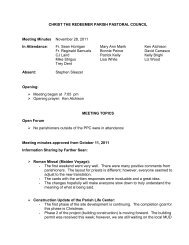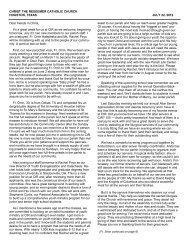Palm Sunday - Christ The Redeemer Catholic Church
Palm Sunday - Christ The Redeemer Catholic Church
Palm Sunday - Christ The Redeemer Catholic Church
You also want an ePaper? Increase the reach of your titles
YUMPU automatically turns print PDFs into web optimized ePapers that Google loves.
Breaking Open the Word<br />
by Mary Birmingham<br />
Breaking Open the Word<br />
<strong>Palm</strong> <strong>Sunday</strong> of the Lord’s Passion C<br />
<strong>Christ</strong> Carrying the Cross as portrayed by EL GRECO - Domenikos<br />
<strong>The</strong>otokopoulos, 1580
SIGN OF THE CROSS<br />
OPENING PRAYER<br />
. Option 1. Use Opening Prayer from the <strong>Sunday</strong> Liturgy.<br />
. Option 2.<br />
Sing or recite the following hymn.<br />
All glory, laud and honor,<br />
To <strong>The</strong>e, <strong>Redeemer</strong>, King,<br />
To Whom the lips of children<br />
Made sweet hosannas ring.<br />
Thou art the King of Israel,<br />
Thou David's royal Son,<br />
Who in the Lord's Name comest,<br />
<strong>The</strong> King and Blessed One.<br />
<strong>The</strong> company of angels<br />
Are praising <strong>The</strong>e on High,<br />
And we with all creation<br />
In chorus make reply.<br />
<strong>The</strong> people of the Hebrews<br />
With psalms before <strong>The</strong>e went;<br />
Our prayer and praise and anthems<br />
before <strong>The</strong>e we present.<br />
To <strong>The</strong>e, before Thy passion,<br />
<strong>The</strong>y sang their hymns of praise;<br />
To <strong>The</strong>e, now high exalted,<br />
Our melody we raise.<br />
Thou didst accept their praises;<br />
Accept the prayers we bring,<br />
Who in all good delightest,<br />
Thou good and gracious King.<br />
(A traditional hymn for <strong>Palm</strong> <strong>Sunday</strong>, public domain)<br />
© Mary Birmingham, 2010. All Rights Reserved.<br />
2
LITURGICAL CONTEXT<br />
Today is <strong>Palm</strong> <strong>Sunday</strong> of the Lord’s Passion, the beginning of the holiest week in<br />
our church calendar. Today we tell the story of the Lord’s Passion and death<br />
from the evangelist Luke’s perspective.<br />
Refer to Word and Worship Workbook Year C (Paulist Press) for a thorough<br />
treatment of <strong>Palm</strong> <strong>Sunday</strong> of the Lord’s Passion.<br />
Today we commemorate the Lord’s triumphant entry into Jerusalem as well as<br />
his passion and death. We celebrate the Lord’s entry by processing with palm<br />
branches.<br />
<strong>Palm</strong>s were added to the solemn liturgy @the eighth century. Pagan belief<br />
suggested that palm branches contained special magical powers. <strong>Christ</strong>ianity<br />
appropriated the pagan use of palms by having them blessed, and using them in<br />
devotional practices intended to ask for protection from storms and from evil.<br />
<strong>The</strong>re are three forms for the procession with palms. <strong>The</strong> first form hearkens<br />
back to the earliest fourth century ritual. <strong>The</strong> liturgy begins in another place,<br />
palms are blessed, and the gospel is proclaimed and all solemnly process with<br />
branches into the church. <strong>The</strong> second, less solemn form begins in the church,<br />
outside the sanctuary. <strong>The</strong> gospel is proclaimed and the presider and others<br />
process with palm into the sanctuary. <strong>The</strong> third and least solemn—the simple<br />
entrance--begins with the presider processing into the church. <strong>The</strong> procession<br />
with palms is not to overshadow the proclamation of the passion.<br />
Catechist invites participants to respond to the following questions in groups of two,<br />
then surface insights in the wider group. (@Five to seven minutes)<br />
What spoke to your heart in today’s liturgy?<br />
What reading, symbol, music, homily, spoke to you and why did it speak to you?<br />
If time is a consideration, there may not be time to reflect on all of the readings of<br />
today’s liturgy, you may only have time to concentrate on the Passion. You could<br />
simply read the interpretive material to give participants a sense of those texts and<br />
omit the reflection questions or you may omit some of the readings altogether.<br />
Participants could be given the reflection questions that were omitted for reflection<br />
in their journal throughout the coming week.<br />
Entrance Gospel: Luke 19: 28-40<br />
We are told Jesus came from Bethany and Bethpage—house of the poor and<br />
house of figs—both were reminders of the judgment against Jerusalem.<br />
© Mary Birmingham, 2010. All Rights Reserved.<br />
3
Jesus was one of God’s poor among the poor heading for the place where<br />
prophets are put to death. Like the fig tree, Jerusalem did not produce what it<br />
was intended to produce. Judgment is against the holy city.<br />
Jerusalem was considered a holy place. In today’s Gospel Luke uses the secular<br />
name for Jerusalem rather than the holy name. She was not deserving of her<br />
holy status.<br />
<strong>The</strong> long awaited messiah was prophesied to enter Jerusalem on the back of a<br />
donkey. Successors to ancient thrones mounted a donkey and rode triumphantly<br />
to accept their new royal throne.<br />
Jesus, the King enters Jerusalem as King and as the one who would come to save<br />
the world.<br />
Jesus processes to his coronation that would ultimately be a crown of thorns and<br />
the cross.<br />
<strong>The</strong> peace the angels proclaimed at his birth comes to fulfillment now in his<br />
death—only through his death will the peace of Eden be restored.<br />
Catechist invites participants to respond to the following questions in groups of two,<br />
then surface brief insights in the wider group.<br />
Consider your own personality and your faith, as you understand yourself.<br />
Do you think you would have been among those who waved their palms and<br />
later turned against Jesus with the rest of the crowd or would you have been<br />
among those who waved their palms and stood by him?<br />
What are the implications and challenge of your honest reflection?<br />
First reading Isaiah 50: 4-7<br />
Third song of the Servant of God<br />
⊕ <strong>The</strong> servant in Isaiah’s reading would not be deterred in his mission to proclaim<br />
God’s word. <strong>The</strong> people were tired of his futile optimism in the face of their<br />
suffering in exile. God gave him a word to speak to the people and nothing<br />
would keep him from doing the will of God.<br />
⊕ <strong>The</strong> <strong>Christ</strong>ian community believed that the suffering servant of Isaiah was Jesus.<br />
Jesus, like the servant, would not be deterred from his appointed mission—to<br />
love God’s people, to teach them, to save them and to free them by his sacrificial<br />
death on the cross.<br />
© Mary Birmingham, 2010. All Rights Reserved.<br />
4
⊕ Jesus’ faithfulness to the mission God gave him resulted in his death (the fate of<br />
all prophets).<br />
Catechist invites participants to respond to the following questions in groups of two,<br />
then surface brief insights in the wider group. Catechist responds with a “brief” story<br />
from his or her life. See appendix #1 for an example.<br />
Jesus was the Messiah and Savior, however he was also a Prophet. Prophets often<br />
bring a message that people resist—change is difficult and people do not like<br />
being challenged, especially people in power. If we are all baptized into Jesus’<br />
priestly, royal and prophetic ministry, then we too are called to speak a prophetic<br />
word—even if it brings wrath down upon our heads. Can you imagine a situation<br />
in your life in which you might be called upon to speak a prophetic word? What<br />
would be the result? What are the implications of living the prophetic life? Jesus<br />
gave us an example—what are we to learn from his example?<br />
Second Reading Philippians 2: 6-11<br />
God’s Son though he was, Jesus took the form of a slave.<br />
⊕ Many scholars believe that this is a hymn that was used in very ancient liturgies.<br />
⊕ Jesus humiliated himself, took the form of a slave and thus saved the world. He<br />
entered the human condition—he learned first hand what it meant to be<br />
rejected, betrayed, misunderstood, maligned, gossiped about, and hated. He<br />
was treated as a criminal.<br />
⊕ Jesus’ perfect kenosis (outpouring of himself in total abandonment and<br />
humiliation) resulted in the resurrection and by extension the salvation of the<br />
human race.<br />
⊕ Paul was asking his factious community to accept the posture of Jesus. Jesus<br />
could have claimed special rights of nobility. He chose instead to come as one<br />
among the poor—to come as a slave. Paul reminds his divided community that<br />
if they would only assume Jesus’ posture of self-abasement, there would be no<br />
need for divisions in the community.<br />
⊕ Jesus “became sin”. He entered the human condition—he became one with us.<br />
He was like us in all things except sin.<br />
© Mary Birmingham, 2010. All Rights Reserved.<br />
5
Catechist invites participants to respond to the following questions in groups of two,<br />
surface brief insights in wider group. Catechist responds with a “brief” story from<br />
his or her life. See appendix #2 for an example.<br />
Imagine how easily we get caught up in petty animosities, jealousies, and hatreds,<br />
not just of our own making but the making of others as well. <strong>The</strong> dark side of the<br />
human spirit is sorely tempted to enter the fray—to condemn others. Imagine<br />
how difficult it was for Jesus to keep his head above the fray. People get angry<br />
when others refuse to get caught up in sinful patterns with them. What does this<br />
reading teach us about Jesus? What does he have to teach us about all human<br />
relationships and the power struggles that take place within them? What is Jesus’<br />
response? What are the implications of Jesus’ response?<br />
Gospel: John 8: 1-11<br />
Jesus saves the woman caught in adultery and challenges her accusers.<br />
⊕ It is important to remember the context of the Passion story as told by the<br />
evangelist Luke. Luke was trying to portray Jesus in a balanced way in the face<br />
of Roman rule. Secular ancient sources record Jesus as a criminal deserving of<br />
death. Luke softens this portrayal and paints Pilate as a fair arbiter who<br />
affirmed his innocence.<br />
⊕ Self-serving, self-righteous men put Jesus to death. However, there were among<br />
them very religious, spiritual men who thought Jesus was a threat to Judaism<br />
and the Law of God. It is a reminder to us that we could very easily have been<br />
among those shouting for his death.<br />
⊕ Jesus takes his disciples to Mount Olivet to pray, as he did throughout his entire<br />
ministry. Luke’s Jesus is a praying Jesus. Jesus asks his Father to strengthen him<br />
for the trial ahead, to help him persevere to the end—to be faithful to God’s will.<br />
⊕ It is important to note that God could not will an evil action. Murder is an evil<br />
action. God did not will his Son’s murder. God willed his Son’s faithfulness<br />
and perseverance no matter what the consequences. Jesus’ faithfulness resulted<br />
in his death.<br />
⊕ <strong>The</strong> word agony is translated to mean excessive tension that produces sweat in an<br />
athlete before a serious event. Jesus could only imagine what lie ahead.<br />
⊕ Peter is in anguish as he watches the face of his Master—not only because of his<br />
denial, but also because of the treatment his Master is receiving. <strong>The</strong> scene is<br />
dripping in irony. <strong>The</strong> authorities mocked and taunted Jesus calling him a<br />
© Mary Birmingham, 2010. All Rights Reserved.<br />
6
prophet. Not that long ago Jesus prophesied that he would die a prophet in<br />
Jerusalem.<br />
⊕ He is led to the Sanhedrin. He does not call himself the Son of God or give his<br />
accusers reason to execute him.<br />
⊕ Herod professes Jesus’ innocence. Jesus’ ministry of reconciliation extended to<br />
these two secular rulers who previously were enemies and now as a result of<br />
this event were reconciled.<br />
⊕ Jesus forgives those who brought charges against him. It would seem that he<br />
does not hold them responsible. Commentators suggest that Luke does the<br />
same thing in the Acts of the Apostles, signifying that the entire situation was<br />
complicated. It is one thing to be aware of who Jesus was after the fact, quite<br />
another to be fully aware of his claims being authentic as they were unfolding.<br />
⊕ Jesus’ healing, reconciling mission continues throughout his ministry up to his<br />
last breath. <strong>The</strong> religious leaders scoff at his offer of forgiveness but the people<br />
do not.<br />
⊕ Luke’s Passion narrative is the only account of Jesus’ death in which the thief is<br />
saved at the eleventh hour and is offered salvation and eternal life.<br />
⊕ <strong>The</strong> Roman centurion also witnesses to Jesus’ innocence.<br />
⊕ Luke’s Jesus continued his ministry of unconditional love, healing, reconciliation<br />
and salvation all the way to Calvary.<br />
Catechist invites participants to respond to the following questions in small groups<br />
of four. Use the last three or four minutes to surface the insights in the wider group.<br />
(@ Ten-twelve minutes)<br />
What touched you the most in this Passion narrative?<br />
How would you describe the primary message of the Passion to a non-believer?<br />
With whom do you most relate? Jesus? Pilate? Herod? <strong>The</strong> thief? <strong>The</strong> religious<br />
leaders? <strong>The</strong> crowd?<br />
What do you think of a God that would allow the brutal death of his only Son?<br />
What does that tell us about God? About God’s relationship to us? Why did God<br />
allow his Son’s death? (See appendix # 3 below) What are the implications?<br />
What is the challenge of the Passion? What does this passage call us to as<br />
<strong>Christ</strong>ians?<br />
© Mary Birmingham, 2010. All Rights Reserved.<br />
7
In what way does it invite you to grow in faith and to be a better disciple?<br />
Catechist invites participants to silently reflect on the following question.<br />
(@ Three minutes)<br />
IMPLICATIONS<br />
After reflection on today’s liturgy, what one thing is God asking of you at this<br />
time in your life?<br />
What obstacles stand in the way of following God’s call?<br />
In what way does the Passion of <strong>Christ</strong> invite you more deeply into <strong>Christ</strong>’s<br />
life, death and resurrection? (A good question for ongoing reflection in your<br />
journal throughout the week.)<br />
CLOSING PRAYER<br />
If this is a catechumenal session, end the session with a minor rite—a blessing or<br />
minor exorcism, RCIA # 90-97.<br />
and/or<br />
Prayer of Pope Clement XI<br />
Lord, I believe in you: increase my faith.<br />
I trust in you: strengthen my trust.<br />
I love you: let me love you more and more.<br />
I am sorry for my sins: deepen my sorrow.<br />
I worship you as my first beginning.<br />
I long for you as my last end.<br />
I praise you as my constant helper.<br />
And I call you as my loving protector.<br />
I want to do what you ask of me:<br />
In the way you ask, for as long as you ask, because you ask it.<br />
Let me love you Lord as my God.<br />
And see myself as I really am: a pilgrim in this world.<br />
A <strong>Christ</strong>ian called to respect and love all those lives I touch.<br />
© Mary Birmingham, 2010. All Rights Reserved.<br />
8
1.<br />
APPENDIX<br />
Right now our country is embroiled in so many divisive issues. Those on the right<br />
think they have God’s favor, as do those on the left. Each group is unbending,<br />
unyielding and closed to listen to one another’s perspectives.<br />
It is difficult to preach the Gospel in the midst of the political camps that dot the<br />
landscape today. If I am pro-life from womb to tomb; if I treasure the precious life of<br />
the unborn and believe that baby has a right to live; if I am vehemently opposed to the<br />
death penalty because I believe the power over life and death belongs to God; if I am in<br />
favor of relaxing our borders because all I can think of is putting myself in the shoes of<br />
those who are trying to secure a better life for their families—a roof over their head,<br />
food on the table, education for their children and meaningful employment; if I favor<br />
helping illegal immigrants become legal, productive members of society; if I favor<br />
health care for all of our citizens as a human right; if I believe God put us on this earth<br />
to be good stewards of it and thus calls us to pay attention to all that we do to hurt<br />
God’s creation, I do not fit in any one political party. No political party today embraces<br />
a Gospel perspective.<br />
I embrace such issues because I believe they are constitutive of the Gospel. However, it<br />
is very difficult to say such a thing in our communities today without being accused of<br />
being a proponent of a particular party. It is also difficult to maintain a clean heart in<br />
the midst of all the controversy. Like it or not, we are impacted by political ideologies<br />
of the day.<br />
All I can do is forge ahead and ask that God give me a clean heart, challenge my<br />
motives and when I am wrong correct me. My fear is that when I do exercise my<br />
prophetic role I am truly exercising the mind and heart of God. We can fool ourselves.<br />
Jesus went to his death because of human sin. I am called to pattern my life after his<br />
sacrificial life and death.<br />
<strong>The</strong> prayer of the psalmist must be ever on my lips if I am to preach and live a just and<br />
true word, “Create in me a clean heart O Lord. Put a steadfast spirit in me; cast me not<br />
away from your presence, and take not your spirit from me. Give me the joy of your<br />
salvation and a willing spirit sustain in me. I will teach transgressors your ways, and<br />
sinners shall return to you. (Ps. 51)” Jesus went to his death because he did not care<br />
what apple cart he upset. He was a voice for truth and righteousness. He spoke up for<br />
those who could not speak for themselves. It is important for me to remember that<br />
Jesus had very little tolerance for the self-righteous. It was they who were most<br />
responsible for his death. I pray that God cast away any self-righteousness lurking<br />
within me—that he creates in me a clean heart. That is why he died. That was his gift<br />
to all of us. May I live up to so great a gift!<br />
© Mary Birmingham, 2010. All Rights Reserved.<br />
9
2.<br />
I once was heavily embroiled in a parish controversy. Sides were taken. Friends were<br />
forged only with people on one’s own side. When we gathered with friends on our side<br />
of the controversy we often gave into the temptation to demonize those with whom we<br />
had issues. I remember the feeling of dripping sin creeping up my spine and into my<br />
consciousness. It was most unpleasant. I remember the looks and stares when one of us<br />
tried on occasion to be a voice of reconciliation or at the very least try to stop the<br />
demonization.<br />
<strong>The</strong> same thing was happening on the other side of the controversy. A man came up to<br />
me after all had blown over and told me he wanted to apologize. He was new to the<br />
parish. He was told he should hate me and he admitted that he did hate me without<br />
having ever met me. He was so sorry for his sin. I too apologized for my contribution.<br />
I often reflected on how it must have been for Jesus. Fully human, like us in all ways<br />
but sin, he NEVER gave in to those temptations. He was always the voice of love. No<br />
wonder it led to his death. People can feed off of the crowd mentality of anger, hatred<br />
and accusations. Jesus died showing us another way. My prayer is that I have the<br />
courage to exercise my prophetic role if ever faced with a similar situation.<br />
3.<br />
Whenever I question why God willed the death of his only Son I refer to Louis Marie<br />
Chauvet. Within every sacrament we experience the total kenosis ----self-emptying of<br />
Jesus on the cross---an emptying he gives as a sign of God’s love for the human race.<br />
Sacramental theologian Louis Marie Chauvet insists that in every sacrament we are<br />
privileged participants in the drama between the Father and the Son—the son who<br />
completely empties himself in the face of total abandonment. <strong>The</strong> innocent tortured<br />
Son who echoes psalm 22’s lament of an innocent sufferer—“My God, My God why<br />
have you abandoned me?” In the sacraments we are given privileged access to the<br />
intimacy between the Father and the Son---the grief-stricken Father, the near despairing<br />
and ultimately abandoned Son.<br />
<strong>The</strong> Father Jesus defended with his life is the same Father who could send armies to<br />
rescue him. Yet, what does God do? God remains silent. <strong>The</strong> Father hides his face.<br />
What kind of a Father is he? He is a Father not just of the Son, but of all those the Son<br />
came to save. Jesus had work left to do—he had to take his love for humanity to its<br />
final and ultimate conclusion. To be in solidarity with the human condition meant that<br />
Jesus had to experience death in the face of God’s silence, a God who spares no one<br />
from it—not even his own faithful Son.<br />
© Mary Birmingham, 2010. All Rights Reserved.<br />
10
Jesus had to experience the absolute separation of human death and abandonment<br />
before he could be truly one with the human race. Chauvet insists that the Paschal<br />
Mystery that is present in the sacraments introduces us to a <strong>Christ</strong> who knows what it<br />
means to be abandoned, tortured and seemingly without hope –who poured himself<br />
out for every broken person in the world----for us in our times of abandonment and<br />
who invites us to offer the same kenosis for others.<br />
Every time we come to the sacraments we are invited to empty ourselves as offering for<br />
those who are most abandoned and in so doing share in the ongoing redemption of the<br />
cross. What <strong>Christ</strong> says to us in the sacraments is: DO you know how much I love you?<br />
“This much.” <strong>The</strong>n he stretched out his arms and he died.<br />
© Mary Birmingham, 2010. All Rights Reserved.<br />
11
CONNECTING THE LITURGY WITH THE DOCTRINES OF THE CHURCH<br />
Possible doctrinal themes that flow from the celebration of the liturgy for the First<br />
<strong>Sunday</strong> of Lent, Cycle C:<br />
. Cross of <strong>Christ</strong><br />
. Sacraments<br />
. Overview of Triduum<br />
.<br />
.<br />
Other themes may be chosen as well--choose from the index of doctrinal topics and<br />
create your own connecting statement.<br />
<strong>The</strong> following statements make the appropriate connections between the doctrinal<br />
issue you have chosen and the liturgy of the day.<br />
CROSS OF CHRIST<br />
Today’s liturgy is an extended meditation on the cross of <strong>Christ</strong>. Let us continue<br />
our reflection on the cross of <strong>Christ</strong> in our extended session today. Today’s<br />
doctrinal session will focus on the CROSS OF JESUS CHRIST.<br />
SACRAMENTS<br />
Every sacrament makes present the Paschal Mystery of <strong>Christ</strong>. In other words,<br />
every sacrament brings before us <strong>Christ</strong>’s sacrificial death on the cross and his<br />
resurrection from the dead. We remember and made present those saving events<br />
in every sacramental celebration. Thus today’s extended session will focus on the<br />
SACRAMENTS of the <strong>Church</strong>.<br />
OVERVIEW OF TRIDUUM (see below)<br />
Today’s extended session will focus on the outline you have just been given that<br />
expresses what we are about to celebrate in the liturgies of Holy Week.<br />
© Mary Birmingham, 2010. All Rights Reserved.<br />
12
HANDOUT: TRIDUUM: THE THREE DAYS<br />
Triduum<br />
<strong>The</strong> Triduum begins with the Holy Thursday Evening Mass of the Lord’s Supper<br />
and includes the Good Friday celebration of the Lord’s Passion, Holy Saturday<br />
rites for the elect, the Easter Vigil, Easter <strong>Sunday</strong> liturgies and ends with Evening<br />
Prayer on Easter <strong>Sunday</strong> night.<br />
<strong>The</strong> Triduum is to the year what <strong>Sunday</strong> is to the week--the “Mother of all feasts”.<br />
It is a one, three-day celebration of the Lord’s passion, death and resurrection.<br />
<strong>The</strong>re is no official end to the Holy Thursday and Good Friday liturgies as it is<br />
one continuous celebration.<br />
<strong>The</strong> Triduum is the most important time of the year for <strong>Christ</strong>ians to gather to<br />
remember <strong>Christ</strong>’s great sacrifice for us. We, in fact bring that sacrifice into our<br />
midst. It is the liturgy [lasting three days] in which the <strong>Church</strong> remembers and<br />
makes present our salvation history. It is the liturgy in which the <strong>Church</strong><br />
generates itself through baptism and regenerates itself through a renewal of<br />
baptism.<br />
Outline of Triduum<br />
1. Triduum is the “Mother of all feasts”. It is one feast that spans three days-- a<br />
one three-day celebration of the Lord’s passion, death and resurrection<br />
All other feasts hinge on this great feast.<br />
Culmination of entire liturgical year.<br />
It is the feast in which the <strong>Church</strong> does what it was created to do:<br />
generate itself through baptizing.<br />
2. Paschal Mystery<br />
Triduum is a celebration of <strong>Christ</strong>’s life, death, resurrection,<br />
ascension, sending of the Spirit at Pentecost and promised return.<br />
Triduum is one feast spread over three days in which the Paschal<br />
mystery is made present.<br />
It is the Passover of the Lord made present, the Pascha<br />
Greek pascha, Hebrew, Pesach: “passing by” or “passing through”.<br />
Refers to Israel’s saving event--Exodus. “Angel of death passed<br />
over the houses of the Israelites. Hebrew slaves were led safely out<br />
of bondage through the Red Sea and given safe passage to the<br />
Promised Land.”<br />
© Mary Birmingham, 2010. All Rights Reserved.<br />
13
<strong>Christ</strong>ians appropriated the feast of Passover to their understanding of Jesus’<br />
pasche [his life, death and resurrection--his passing over from death to resurrected<br />
life].“He passed through the sea of suffering and death and led the people of God<br />
to a communion of grace with the Father.”[Augustine] We remember the Paschal<br />
mystery, and it becomes present.<br />
Paschal mystery gave birth to the church.<br />
Through <strong>Christ</strong>’s saving act the church was born.<br />
Duration. It is one feast that spans three days. <strong>The</strong>re is no ending to<br />
Thursday and Friday.<br />
<strong>The</strong> Triduum is the night [spanning three days] that we: wash feet,<br />
offer gifts for the poor, venerate the cross, keep vigil, share stories of<br />
the history of salvation, light a new fire, carry candles behind the<br />
Paschal Candle, bless water, baptize with water, renew our baptism,<br />
anoint with oil, put on new clothes, offer thanks and praise to God,<br />
eat and drink <strong>Christ</strong>’s Body and Blood, sing, process and celebrate in<br />
the reign of God!<br />
B. HOLY THURSDAY<br />
Exodus account of the Passover. We are reminded that Jesus is our paschal<br />
lamb. That it is his passing over from death to life that we remember and<br />
make present.<br />
Paul’s letter to the Corinthians: earliest account of the Last Supper--furthers<br />
the connection between service and Eucharist--To worthily eat his Body we<br />
must serve his people.<br />
John’s Account of the Last Supper, the washing of the feet. Preparation for the<br />
meal was to be washing the feet of others. John invites us to live the<br />
Eucharist--to serve, to forgive, to die.<br />
Celebration of the institution of the Eucharist, the priesthood, <strong>Christ</strong>’s<br />
commandment to love one another–washing of feet.<br />
Enough Eucharist is consecrated for Holy Thursday and Good Friday.<br />
Eucharist: one loaf, one Body in <strong>Christ</strong><br />
C. GOOD FRIDAY<br />
We do not go into Good Friday pretending we do not know the rest of the story.<br />
We remember his passion knowing full well that Jesus rose from the dead. This<br />
is why we proclaim John’s gospel. OF all the passion narratives it is the text that<br />
most expresses Jesus’ divinity and mastery over his destiny. Thus, it is GOOD<br />
FRIDAY. Jesus willingly gave his life for the sins of the world–that is GOOD.<br />
© Mary Birmingham, 2010. All Rights Reserved.<br />
14
Liturgy of the Word:<br />
Reading from Isaiah: <strong>The</strong> suffering Servant who gave his life for the many.<br />
Reading from the Letter to the Hebrews: <strong>Christ</strong> the High Priest, the source of our<br />
salvation is extolled and exalted.<br />
Passion according to John: Jesus returns to the place he temporarily left. Aware of<br />
his preexistence. He is not a victim. He knows the rest of the story. He is in control.<br />
Jesus <strong>Christ</strong>, Victor--complete control of his destiny.<br />
Calvary–the actual birthday of the <strong>Church</strong>: Water and blood from his side-baptism<br />
[water] and Eucharist [blood] <strong>Church</strong> was born at the foot of the cross through the<br />
water of baptism and the blood of Eucharist.<br />
Veneration of the Cross<br />
Sign of Victory. It expresses the church’s faith in and gratitude to <strong>Christ</strong> who turned the<br />
wood of an instrument of torture into the means of redemption and the sign of God’s infinite<br />
love.<br />
<strong>The</strong> cross stands as an irresistible call to love God who knows us best and loves us<br />
most.<br />
<strong>The</strong> cross stands as a sign of our participation in the Paschal Mystery–our<br />
participation in the redemption of <strong>Christ</strong> accomplished at Calvary.<br />
Holy Communion is distributed.<br />
HOLY SATURDAY: EASTER VIGIL<br />
Morning Preparation Rites: Morning Prayer and Preparation Rites<br />
<strong>The</strong> elect are spiritually prepared for their initiation through the preparation rites.<br />
Ephphatha: We pray that the ears be opened to more fully hear and proclaim the<br />
word of God<br />
Creed: We return to the CREED as immediate preparation for the profession of faith<br />
they will make that night.<br />
Presentation of the Lord’s Prayer. We present the Lord’s Prayer as immediate<br />
preparation for the evening when they will become adoptive children of God.<br />
Easter Vigil<br />
<strong>The</strong>re are four parts to the Easter vigil: Service of Fire, Service of the Word,<br />
Service of Baptism and Liturgy of the Eucharist.<br />
Symbols of the Triduum/Easter Vigil<br />
© Mary Birmingham, 2010. All Rights Reserved.<br />
15
<strong>The</strong>re are nine dominant symbols that we use in the process of making church at the<br />
Easter vigil. Those symbols tell us who we are. <strong>The</strong> symbols are: Light/Fire; People<br />
of God; Cross; Word; Water; Garment; Oil; Laying on of Hands; Bread; Wine.<br />
<strong>The</strong> Easter vigil is the night when heaven is wedded to earth--when the church gives<br />
birth.<br />
It is the night we make church---our identity is in the symbols.<br />
Service of Fire<br />
We gather.<br />
Symbol of Community: Who are we? We are the people of God, a pilgrim<br />
people establishing the reign of God on earth as we journey to our final<br />
destination.<br />
Symbol of Cross: Who are we? We are people who are willing to take up our<br />
cross and live the Paschal Mystery of <strong>Christ</strong>.<br />
Symbol of light/fire: Who are we? We are people who gather around a holy<br />
fire reminiscent of our ancestors who handed down our stories of God’s<br />
saving work. We are people who follow <strong>Christ</strong>, the Light of the World. We<br />
are people who process in freedom behind the Light of <strong>Christ</strong> to the Promised<br />
Land—the reign of God, here, now and not yet. We are people who follow the<br />
Light that dispels the darkness of sin and death--the Light that lights our<br />
way.<br />
Service of the Word<br />
Symbol of Word---Who are we? We are people who tell the stories of our salvation<br />
history.<br />
We are there and it is now when the Spirit hovers over the waters of<br />
creation. We are there and it is now when the Lord God made men and<br />
women and saw they were GOOD. We are there and it is now as<br />
Abraham our father in faith listens to God, carries out God’s will and<br />
is spared from using his sacrificial knife on his beloved son Isaac, We<br />
are there and it is now when the Lord God saved the Israelites from<br />
Pharaoh and led them roughshod through the sea. We are there and it<br />
is now as Isaiah tells us that God’s love will never leave us and that we<br />
are to come and feast, drink wine and eat rich foods. We are there and<br />
it is now as Ezekiel tells us that we will be given a new spirit and clean<br />
© Mary Birmingham, 2010. All Rights Reserved.<br />
16
Service of Baptism<br />
water will be sprinkled upon us. We are there and it is now when Paul<br />
gives us the great sermon: “You who have died with <strong>Christ</strong> have been<br />
raised with him”. We are there and it is now when we hear the story<br />
of all stories----the ULTIMATE reason for our salvation---<strong>The</strong><br />
resurrection of the Son as told to us by the evangelist Luke.<br />
Symbol of water and garment, oil, laying on of hands. Who are we? We are people<br />
who have died to sin through the waters of baptism, who have put on <strong>Christ</strong> and<br />
upon whom hands have been laid. We are anointed for service in the Lord’s<br />
court.<br />
<strong>The</strong> elect are plunged into the water---they die to self and are born anew by<br />
water and the Spirit into the <strong>Christ</strong>ian community. <strong>The</strong>y are cleansed of the<br />
ravaging power of original sin. <strong>The</strong>y put on <strong>Christ</strong> with the new garment–<br />
they become the new person in <strong>Christ</strong>. <strong>The</strong> faithful renew that same<br />
commitment in their own lives.<br />
<strong>The</strong>y are slathered with the oil of the Spirit---that soothing, healing,<br />
permanent bond----they are signed, sealed and delivered ----into the life of<br />
<strong>Christ</strong>. <strong>The</strong>y are touched with the power of God’s hand–they are given the<br />
gift of the Holy Spirit, forever sealed into <strong>Christ</strong>’s service.<br />
Liturgy of Eucharist:<br />
Symbols of Bread and Wine. Who are we? We are people who feast on the Bread of Life, who<br />
become what we have received, who are willing to allow our bodies to be broken as <strong>Christ</strong><br />
allowed his to be broken for us. We are people who drink the Blood of <strong>Christ</strong>, the <strong>Christ</strong><br />
whose blood veritably runs through our veins. We are people who are willing to shed our<br />
blood for others as <strong>Christ</strong> shed his blood for us.<br />
<strong>The</strong> neophytes put on <strong>Christ</strong> with the new white garment. <strong>The</strong>y are led with joyful<br />
fanfare to the Eucharist table.<br />
Baptism is not the goal of initiation–Eucharist is.<br />
Through the Eucharist the neophytes are fully incorporated into the Eucharistic<br />
community, signified by the one loaf, the one body in <strong>Christ</strong>. Bread that gives life, the<br />
staff of life, sustenance for the journey.<br />
Sharing in the cup is the fullest sign of the Covenant.<br />
<strong>Christ</strong> shed his blood for the sins of the word—his Blood fully incorporates us into his<br />
death and resurrection.<br />
No one should miss this night that is different from all other nights--the night we make<br />
<strong>Church</strong>---<strong>The</strong> night our symbols are most fully expressed.<br />
© Mary Birmingham, 2010. All Rights Reserved.<br />
17


